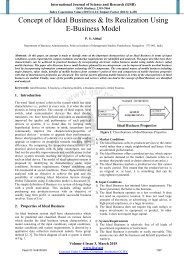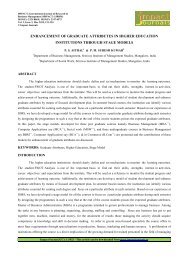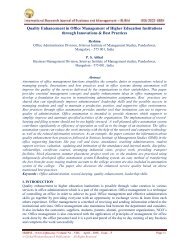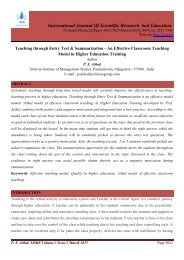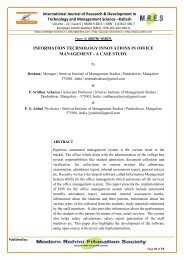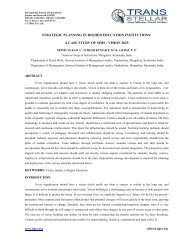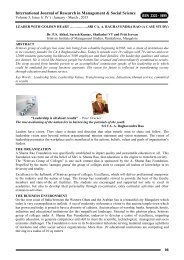How Innovations and Best Practices can Transform Higher Education Institutions : A case study of SIMS
Education has become competitive so as the educational institutions. In order to survive the competition, institutions have to improve the quality of their services. Changes in culture, aspiration and levels of skills required in securing employment for students, force higher education institutions today to rework on their educational models and add value to each and every aspect of their service. Innovations and best practices serve to enhance quality and add value. Srinivas Institute of Management Studies (SIMS), which combines technology, management and social service education has identified and implemented innovations and best practices to differentiate itself among the competitors and to add value in its educational services. In this paper, we have discussed innovations, small and big, develped indigineously and implemented during last four years. They are broadly classified under six key aspects namely "curricular aspects, teaching-learning and evaluation, research, consultancy and extension, infrastructure and learning resources, student support and progression, and governance, leadership, and management". The paper also contains some of the intitutional and individual faculty best practices having visible impact on the quality of higher education imparted by the institution. The best practices concern admission, fees, attendance, teaching, performance, skill building, employability, student involvement, collective learning, value addition, ensuring transparency, information dessimination etc. Finally two institutional best practices are elaborated with its aim of practice, underlying principles and concepts, particular contextual features or challenging issues that have had to be addressed in designing and implementing the practice, and its implementation, including its uniqueness in Indian higher education, evidence of success, identifying the problems encountered and resources required to implement the practice.
Education has become competitive so as the educational institutions. In order to survive the competition, institutions have to improve the quality of their services. Changes in culture, aspiration
and levels of skills required in securing employment for students, force higher education institutions
today to rework on their educational models and add value to each and every aspect of their service. Innovations and best practices serve to enhance quality and add value. Srinivas Institute of
Management Studies (SIMS), which combines technology, management and social service education
has identified and implemented innovations and best practices to differentiate itself among the competitors and to add value in its educational services. In this paper, we have discussed
innovations, small and big, develped indigineously and implemented during last four years. They are
broadly classified under six key aspects namely "curricular aspects, teaching-learning and evaluation, research, consultancy and extension, infrastructure and learning resources, student support and progression, and governance, leadership, and management". The paper also contains some of the
intitutional and individual faculty best practices having visible impact on the quality of higher education imparted by the institution. The best practices concern admission, fees, attendance, teaching, performance, skill building, employability, student involvement, collective learning, value
addition, ensuring transparency, information dessimination etc. Finally two institutional best practices are elaborated with its aim of practice, underlying principles and concepts, particular contextual features or challenging issues that have had to be addressed in designing and implementing the practice, and its implementation, including its uniqueness in Indian higher
education, evidence of success, identifying the problems encountered and resources required to implement the practice.
Create successful ePaper yourself
Turn your PDF publications into a flip-book with our unique Google optimized e-Paper software.
International Journal <strong>of</strong> Management (IJM), ISSN 0976 – 6502(Print), ISSN 0976 - 6510(Online),<br />
Volume 6, Issue 2, February (2015), pp. 83-98 © IAEME<br />
18. Sync Model<br />
This is an attempt towards making the sessions more productive. During the normal lecture<br />
session, students will be addressed a new topic or concept. But students learning factor is improved a<br />
lot, if one makes students learn the concept at the abstract level even before the lecture session. This<br />
is done before winding up a session by disclosing the topic to be addressed in the next session.<br />
[Faculty 18]<br />
19. Group Study<br />
Main objective <strong>of</strong> this is to encourage every one as members <strong>of</strong> a group <strong>and</strong> groups as teams<br />
to gain expertise in a battery <strong>of</strong> aptitude test. Fixing responsibility for individual students in group<br />
<strong>study</strong> encourages accountability. It generates new ideas <strong>and</strong> solutions <strong>and</strong> encourages healthy<br />
competition in teams. Teachers <strong>can</strong> concentrate on weak students. Each group <strong>can</strong> concentrate on<br />
specific category <strong>of</strong> aptitude questions <strong>and</strong> develop expertise which they <strong>can</strong> share with others in<br />
other groups.<br />
[Faculty 19]<br />
20. Virtual Reality<br />
The best practice called Virtual Reality means 'Viewing an unseen'. The major challenge for<br />
the teacher who teaches technical papers is that they find the subject difficult for teaching because<br />
the concepts are purely theory which <strong>can</strong>not be visualised. Animated slide based teaching clearly<br />
give the idea about the subjects.<br />
[Faculty 20]<br />
21. Programming Champ<br />
The aim <strong>of</strong> the practice is to facilitate learning through working in teams especially in the lab<br />
sessions. The practice is to group the students into a team <strong>of</strong> five or six members. Make one student<br />
the leader <strong>of</strong> the team. The leader should plan the work together with the members, make sure that he<br />
finishes his work <strong>and</strong> then help all his team members to finish their work within the stipulated time.<br />
The students come to know about the errors they encounter in programming <strong>and</strong> the strategies to<br />
resolve the errors. At the end <strong>of</strong> the semester, the best team leader is awarded. The best team leader<br />
is adjudged depending on the teams overall performance with respect to completion <strong>of</strong> the task <strong>and</strong><br />
the way the teams understood the concept.<br />
[Faculty 21]<br />
22. Surprise Tests<br />
Surprise tests are tests typically held for a small duration at the end <strong>of</strong> a class. These are tests<br />
typically held for a small duration at the end <strong>of</strong> a class to ensure that students do not lag behind as<br />
the subject is covered. The questions should ideally be attemptable by a regular, attentive student<br />
without preparation. A time based schedule <strong>can</strong> be adopted wherein the test is conducted on a<br />
particular week <strong>of</strong> a month or it <strong>can</strong> be curriculum based, wherein a test is conducted on the<br />
completion <strong>of</strong> a unit <strong>of</strong> the syllabus. One <strong>can</strong> also reduce the element <strong>of</strong> surprise by announcing a<br />
window <strong>of</strong> a few days during which a surprise test <strong>can</strong> be conducted on any day.<br />
[Faculty 22]<br />
23. Active Learning<br />
Students do not learn much just sitting in classes listening to teachers, memorizing prepackaged<br />
assignments, <strong>and</strong> spitting out answers. Active Learning is defined as any strategy that<br />
involves students in doing things <strong>and</strong> thinking about the things they are doing. They must talk about<br />
what they are learning, write reflectively about it, relate it to past experiences, <strong>and</strong> apply it to their<br />
daily lives.<br />
[Faculty 23]<br />
24. Open book exams<br />
Open book exams are tests typically held for a small duration at the end <strong>of</strong> the each chapter.<br />
This ensure that students keep pace with the subject as it progress. The questions should ideally<br />
91




